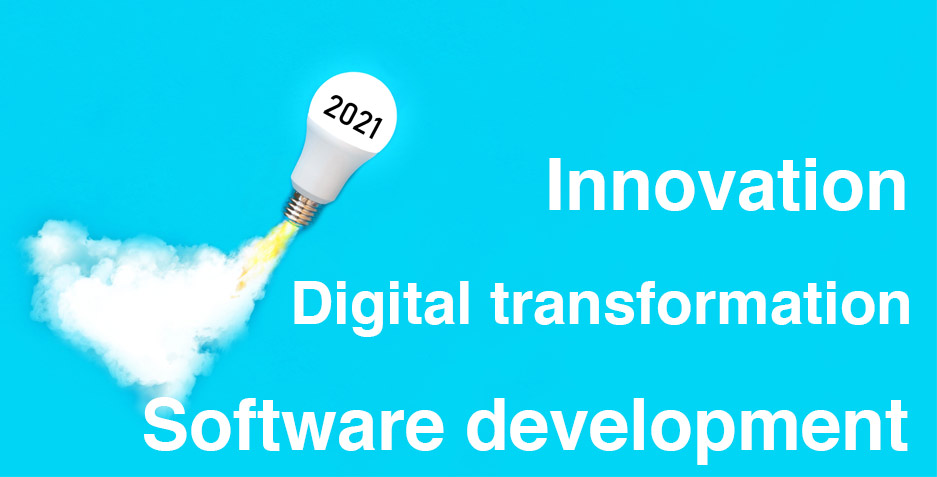Software development trends 2021 are a result of all the changes during the pandemics. A year into remote work and some technology ideas are evolving in the online world. Nowadays we are witnessing a digital transformation that shows no signs of stopping.
IT technology is ever-evolving regardless of the current market conditions. Companies that do not wish to falter behind are investing in digital transformation. Like so many years before, many trends had come, made an impact, kept evolving, or got replaced.
But some technological developments have persisted and keep evolving. So, it forces us to adapt to the new online environment using the available technology. From those foundations, innovations in software development are making human life easier.
Software Development Trends 2021
Some of the tech features today seem possible only in the “Back to the Future” movie. Even Marty would never expect the impact of the pandemic and the change it causes. This growing use of the Internet changes the software requirements. It creates an increasing demand for custom software and modern technology.
Work from Home and its Influence on Software Development Trends 2021
Veterans from Silicon Valley predict that work from home will stay as one of the software development trends in 2021. Companies worldwide are making efforts to modernize their operations. Keeping a fast pace with emerging technology that has developed during the pandemic. Startups and small businesses got their fair share of the market due to lock-down. For example, it seems that the Zoom platform has become a usual tool in every household.
Conglomerates as Microsoft, Google, Cisco, and Verizon are constantly developing and improving their video conferencing tools. Likewise, new ventures are arising in the remote working sector. As the online world becomes a new reality, companies turn to software that can meet their needs.
Thus, the market offers a variety of collaboration software. Much like in the real office, they can share files, screens and have facetime. The trouble is that the companies have a hard time managing remote work operations. But, employees like flexibility and work-life balance.
Following on remote working, LinkedIn conducted a survey. The results show an increase in the productivity of people working from home. Most companies were ready to make it a new reality. Not only would they cut costs but get happy employees as well. However, the sad truth is that some people still do not have adequate working conditions in their household.
Much like the conferencing tools, remote work requires good Internet Bandwidth at least. Likewise, the movement toward remote work has emphasized the importance of cloud platforms. Thus, Cloud technology will have even more advantage over traditional servers.
From the Clouds to the Edge
A few years back, in 2015, Cloud computing was still a new trend. But very few firms were ready to invest in new technology. Nowadays, companies are willing to transfer to affordable cloud platforms.
The renowned organizations are still dominating the market, such as Amazon Web Services (AWS), Microsoft Azure, Google Cloud Platform.
Meanwhile, in the digital space, the quantity of data organization increases daily. The companies that use cloud computing noticed some weaknesses in certain situations. Hence, the Edge solution took over the lead. Its architecture is built to bring data closer to the specified location. Edge design and logic improve response time.
The up-and-coming competitor of Edge is Fog computing. Popular for processing a large amount of data and managing it in a networked environment.
Tim Berners-Lee the inventor of the web, came up with a different method named Project Solid. This allows the user to access data through sign in and within a container. This container method will likely take over the first place.
Going Forward with Low-Code No-Code Application Development
The expansion of low-code/no-code application has caused quite a stir in the industry. There is a popular belief that such applications will leave the developers without a job.
The truth is that the trend of simplifying the code will continue for economic reasons. The less code there is for maintenance, it reduces the costs of the company that uses it. These applications are for people without software engineering skills.
Low-code/no-code applications transition toward standardized off-the-shelf software. Because its implementation is inexpensive the market expects an increase in its implementation. In the following year, 75% of software development will be a low-code solution.
Leading before all are big companies as Amazon with Honeycode development tool and Google AppSheet’s no-code app building platform.
Security Online Old News – Ongoing Trend
Cybersecurity may be old news, but it’s a constant trend that will never go away. Since the beginning of the web, security online has been an active issue. Cyber threats are operating daily on all continents. The only thing standing between them and the end-user is antivirus software.
Companies that moved their workspace online, are often a target. In the past year, threats ran on smartphone applications of the employees. Thus, cybersecurity and testing are of importance for software development trends 2021.
Native App Development
Over 8 billion people worldwide use smartphones each day. By the end of 2020, there were 2.56 million apps available via Google Play Store. Apps are popular for a variety of reasons and with them the ratings of developing platforms.
Recently, the industry noted an increase in the popularity of cross-platform frameworks like:
· React Native
· Flutter
These frameworks can create a native look and feel for Android and iOS. Their performance begs the question: Are Native Apps here to stay in 2021?
Hyperautomation Driven Business
The industry and businesses evolve, modernize and even go through digital transformation. The past year has demonstrated the necessity of improving the competitive stance. Despite the current challenging environment, there are new ways of interacting online.
Hence, hyper-automation is an idea that anything in an organization can be automated. The modernization of digital business can be cost-effective in the long run.
Thus, automation increases efficiency within the company but implementation can be expensive. Many organizations still rely on low productivity technologies.
More Machine Learning and Artificial Intelligence
Artificial Intelligence (AI) is another established trend, it seems its use is ever-growing. European scientists expect it to help enhance the quality of life of citizens both at home as well as at work.
Tractica, the market research company, conducts a survey of the European market. According to them, the software industry will experience significant growth in AI. Relying on numbers Tractica predicts revenue to reach more than 7 billion dollars in 2021.
What does it mean for software development trends 2021?
More businesses, as well as government entities, will get automation. Even though companies see the benefits of AI, many often lack in-house developers. Employing staff with specific expertise can be costly and time-consuming. In other words, many of the businesses opt for outsourcing and near-shoring development.
Large companies like Microsoft, Amazon and Google are already offering all the capabilities of their algorithm for rent. The business that wants to have a recommendation engine on their website can use the service. This massive algorithm renting trend will carry on in 2021.
The recent news of AI has made the front-end developers question their jobs. In particular, one made AI work for him. Using GPT-3 generative pre-trained language model which writes codes. He designed an app in which the AI generates the actual HTML, CSS, and React code. The idea of robots uprising has been the most popular concern when it comes to AI technologies.
Other Technology Trends and Digital Transformation in Post COVID-19 Online Environment
Due to the pandemic, many companies opted for work from home. This includes even the Silicon Valley giants. Many developers decide to move to more affordable cities across the US.
The exodus of software developers created a more competitive job market. The change opens a worldwide market for development teams. In return, this only strengthens the offshoring, near-shoring, and outsourcing service providers. Nowadays the US developers compete with their colleagues around the world.
The remote work paves the way for an increase in nearshore development. Yet, it becomes a strategic model in the wake of the COVID-19 pandemic. The companies’ option for near-shoring because of the costs of hiring in-house developers.
Technology changes caused by the pandemic are visible in every industry in the world. Bitcoin, cryptocurrencies, and Ethereum-based are decentralizing finance services. COVID accelerates the need for payment methods like mobile wallets and contactless payments. During the move to online space, people prefer digital over traditional financial services.
Even the delivery of merchandise has changed. Companies like Amazon and UPS are considering the use of delivery drones. Big companies like Ford are rapidly going through digital transformation. In the last months, the company developed a delivery robot that can climb the stairs. The stories of the future of the digital world seem to happen much sooner than expected.
The software development trends 2021 have a much faster pace reinforced by new technologies. For example, 5G offers a faster transmission speed that outperforms its predecessor 4G. In the ultra-competitive digital world that we’re moving into, organizations either modernize or step on the break of business development.





